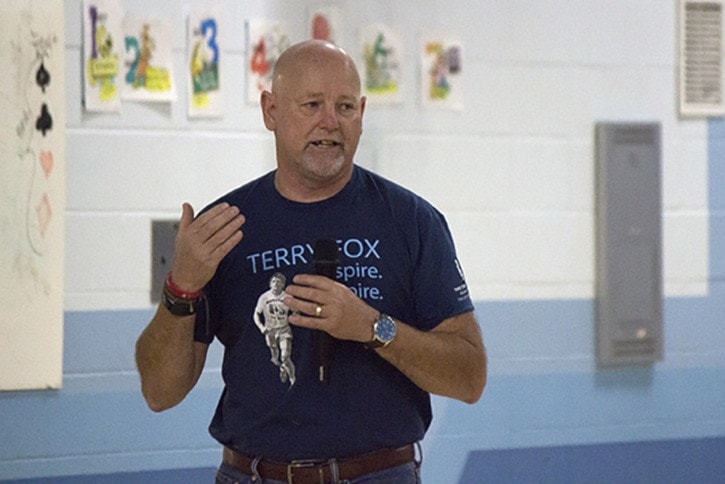On Monday, Sept. 26, Terry’s brother Fred – older by a year and a few months – came to Stettler Elementary School to speak with students and help them get to know Terry as a person.
Terry Fox’s fight with cancer, his run across almost half of the country, and his tragic death more than three decades ago spawned a fundraising juggernaut that has made advances in cancer research possible in Canada and world wide.
Every year, students from schools across the globe raise pledges and walk or run routes in Terry’s memory. The image of Terry on his northern Ontario leg of the journey is an iconic one seared into the Canadian psyche: Terry, in shorts and t-shirt, his prosthetic leg clearly visible as his unique hopping gait carried him westward.
Everyone knew who Terry was. He had become part of the family. When he had to stop his run and revealed his cancer had returned, all of Canada waited to hear the outcome. When he died, all of Canada mourned.
With home photos and anecdotes, Fred Fox turned the image of Terry into a three-dimensional person – a person with whom Fred Fox sometimes argued, or sometimes got up to mischief with. Terry was a person who struggled to keep up his grades and wasn’t very athletic. He wasn’t a hero; he just wanted people to know more about cancer, but in setting out on his Marathon of Hope, Fox became a martyr for the cancer research cause.
“Would the (Terry Fox) Foundation have the sort of success raising money for cancer research it has if Terry had survived? We don’t know,” Fred Fox wondered. “If Terry knew the outcome and had to choose again, I think he’d have chosen this path.”
Fox said his family dealt with Terry’s death in different ways, but it was especially hard on his mother, who was thrust into the spotlight and forced to carry on Terry’s quest.
“I don’t think our mother really had a chance to grieve Terry,” Fox said. “Some of us took longer than others to deal with Terry’s death, but she had to go out there right away.”
Technology, treatment and research has advanced in leaps and bounds since Terry was diagnosed with a type of bone cancer in 1977, almost 40 years ago. The survival rate at the time of his diagnosis was less than 20 per cent, and in an effort to save Terry’s life, his leg was amputated.
Today, the survival rate of the same cancer is in the upper 70s, Fred Fox said, though it sometimes still results in an amputation. The survival rate has climbed because of research and treatment advances. It wasn’t just bone cancer that benefited from Terry’s marathon, though. Today, the Terry Fox Foundation raises money for its Terry Fox Research Institute that hands out grants covering the wide spectrum of cancer research.
“That’s what Terry wanted,” he said. “He wanted it to be for all cancer research. I think he’d be so happy, and so proud, of how Canadians, and people worldwide, responded to his run. He wanted to make a difference to people.”
Given that millions are raised annually from the run, millions of dollars that have benefited almost every aspect of cancer research in Canada, it’s safe to say that Terry has made a difference to a lot of people.
“Everywhere I go, I hear stories,” Fred Fox said. “I hear from people who have survived cancer, or know someone who has, and how grateful they are to Terry. Before Terry, I didn’t know anyone with cancer. It wasn’t out there as an illness. It was quiet.”
The whole Fox family “continues” Terry’s legacy, running in runs and working with provincial and federal aspects of the foundation.
“Terry fully intended to finish his run,” Fred Fox said. “Since he couldn’t, we will.”
